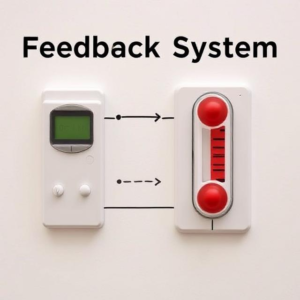Feedback Systems – Explained
A Feedback System is a system where the output (result) is fed back into the system to adjust or control the input (the action taken). In simpler terms, it’s like checking how well something is working and then making adjustments to improve it. A Feedback System is a way for a system to “listen” to its output and make changes if necessary to keep things running as planned. It’s like when you’re cooking and tasting your food to see if it needs more salt. You adjust the seasoning based on how it tastes — that’s feedback in action

How Does a Feedback System Work?
Imagine you have a simple system, like a thermostat controlling a heater in your house.
- The thermostat (the controller) checks the room temperature (the output).
- If the temperature is too low, the thermostat sends a signal to turn on the heater (the system).
- As the temperature starts to rise, the thermostat keeps checking. Once the temperature reaches the desired level, it tells the heater to turn off.
Types of Feedback Systems :
There are two main types of feedback systems:
1. Positive Feedback
- Positive Feedback means that the output increases the input.
- It makes the system more extreme or drives it further in the same direction.
- Microphone feedback: When a microphone gets too close to a speaker, it picks up the sound from the speaker and amplifies it. This causes even louder sound, which the microphone picks up again, making the sound even louder in a loop. This is positive feedback, and it can be very loud and uncontrollable!
2. Negative Feedback
- Negative Feedback means that the output reduces or corrects the input to bring the system closer to a desired state.
- It helps stabilize the system.
- Thermostat: As mentioned earlier, a thermostat uses negative feedback to control the temperature in a room. If the room gets too hot, the thermostat turns the heater off. If the room gets too cold, it turns the heater back on. This keeps the temperature stable, close to your set point.
Why is Feedback Important?
Feedback is essential because it helps systems stay stable and adjust automatically to changes. Without feedback, systems can go out of control or perform inefficiently.
- Stability: Feedback ensures that a system doesn’t go haywire. For example, in a car, the cruise control adjusts the speed constantly to make sure it stays at the set speed.
- Error Correction: It helps fix problems. For example, if a temperature sensor detects that the room is too warm, the thermostat can correct it by turning the air conditioning on.
- Efficiency: Feedback allows the system to use the least amount of energy or effort needed. For example, a washing machine uses feedback to adjust the washing cycle based on the load.
Feedback Systems in Everyday Life
Feedback systems are everywhere in our daily lives! Here are some examples:
- Air Conditioner: It uses feedback to maintain the temperature you set. If the room gets too warm, the AC cools it down, and if it gets too cold, it stops cooling.
- Cruise Control in a Car: This system uses feedback to keep the car at a constant speed. If the car slows down, it speeds up again. If it goes too fast, it slows down.
- Elevator: An elevator uses feedback to know when to stop at each floor. It continuously checks its position and adjusts to reach the desired floor.
Summary :
A Feedback System is like a system that has its own built-in “self-correction” mechanism. It listens to the result (output), checks if it’s what it should be, and makes changes as needed.
- Positive Feedback amplifies the effect (like a microphone causing feedback noise).
- Negative Feedback reduces the effect and stabilizes the system (like a thermostat adjusting the temperature).
Tags: air conditioner feedback, automatic adjustment, control engineering., Control System, cruise control, elevator control, error correction, feedback importance, feedback in automation, feedback in daily life, feedback in electronics, Feedback Loop, feedback mechanism, feedback system, feedback system examples, Feedback Systems, feedback types, input adjustment, microphone feedback, Negative Feedback, negative feedback example, Positive Feedback, real-time control, self-correction, sensor feedback, stability control, system efficiency, system monitoring, system output, system performance, system regulation, system stability, thermostat example


